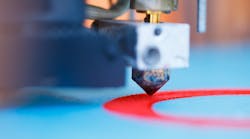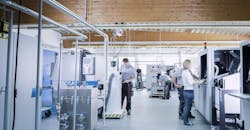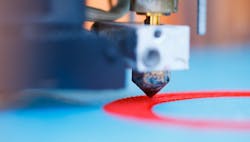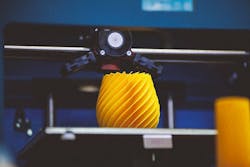A Growing Industry
Additive manufacturing, the process of building 3D objects by adding layer upon layer of material, is certainly here to stay. According to a recent article by Advanced Manufacturing, “not long ago the total 3D printing industry revenue was about [$1 billion], and now many financial institutions five-year revenue forecasts predict the overall industry revenue to be over [$30 billion].” The Internet of Things (IoT), access to new technologies, software, materials, and growing expertise are some of the factors driving this growth.
1. There is a lot to consider, but extruded plastic 3D printing dominates most manufacturing and prototyping, according to data from 3D Hubs. There are lessons to be learned when starting with even a basic easy-to-use extruded plastic printer. An engineer documented his first attempts to print parts in a list of tips to consider when you start 3D printing, “What You Need to Know About 3D Printing.”
As a result, more and more companies are considering additive manufacturing as an option for their production needs. Many companies are now turning to the practice for prototyping. Others are utilizing the technology for full-scale production.
Indeed, 3D printing can truly transform your business. If you are looking to add the efficient use of resources, small-lot production, rapid manufacturing, agile manufacturing, and reverse engineering to your operations, then 3D printing may be an option for you.
Getting Started
So, what would one need to venture into additive manufacturing? The first step is to analyze whether 3D printing is suitable for your company’s needs. An article by Additive Manufacturing entitled “Where Do I Start with Additive Manufacturing?” provides the reader with some excellent questions to ponder before starting out:
- Do you design in 3D?
- Can you 3D print in your desired material?
- Is it possible to print your part sizes on a machine?
- What design guidelines should you follow?
If after considering these questions you still feel that additive manufacturing is for you, you will need to decide what 3D printer and CAD software is suitable for your company’s goals. How can that be done?
2. There are many good guides that fall through the cracks in internet searches. Protolabs, Stratasys, MakerBot, 3D Hubs, and Xometry are good companies to search for educational content. This link here walks you through common 3D printing challenges and how, with a little bit of knowledge, you can master fused deposition modeling. (Image source: Metalworkingnews)
This is a tough question to answer here because it depends on several different things related to your application. You can find an excellent guide for buying a 3D printer here.
As far as choosing 3D printing software, you first need to consider price vs. value, the steepness of the learning curve/user-friendliness, file format compatibility, how well it handles large files, the desired features and modes of design, and operating system compatibility. And of course, you’ll usually want something of industry standard.
Something like Solidworks or Onshape may be an option. Solidworks, for example, has loads of features, is capable of 2D and 3D design, and is compatible with many different files formats. It only operate on Windows, however, and costs a whopping $12,500. Onshape, on the other hand, works on Windows, Mac, and Linux, as well as in a browser. But again, the professional version is quite expensive.
The other major problem with these options is that the learning curve is quite steep, and if you’re not a pro, they can be quite hard to master. Training will be involved.
3. When people consider 3D printing, they often wonder if they can directly make parts. However, one of the ways 3D printing is being used in manufacturing is through custom tooling, fixtures, and molds. This one-way 3D printing is helping in mass production.(Image Source: istockphoto.com)
An alternative would be the all-in-one browser-based software SelfCAD, which is quite simple in terms of learning and usage. The software is popular in schools, as well as among semi-professional engineers and 3D designers. The software allows users to model, sculpt, slice, and print 3D models under one software while being cost-effective. There are also free online CAD software offerings available, such as TinkerCAD. These are often designed to be user-friendly, but tend to not have many of the extra features found on paid versions.
Additive Manufacturing Limitations
Of course, additive manufacturing is no “silver bullet” for your manufacturing woes; it depends on your specific circumstances. According to a Composites Manufacturing Magazine article, potential problems with additive manufacturing include:
- Slow build rates
- High production costs
- Time needed for designing the product, configuring printer settings, and post-processing
- One-at-a-time printing
- Limited component size
- Potential product defects
Nevertheless, in many cases additive manufacturing provides a good return on investment (ROI). An article by Sculpteo entitled “Maximize Your ROI from 3D Printing” gives some examples of how a significant ROI can be achieved. For example, creating a customized, limited series of products using 3D printing can pay dividends. That really is the beauty of additive manufacturing—you can easily produce custom, “hand-drawn” objects that are unique. Moreover, you can quickly implement subtle design changes.
It’s Time to Embrace Additive Manufacturing
Additive manufacturing has become a mainstay of the manufacturing industry. This is certainly reflected in the current market data. Many more companies are looking to implement additive manufacturing-based solutions due to the benefits it offers. Doing so can seem daunting, but with some research, and by taking advice from your colleagues, you will be able get the ball rolling.
Tyler B. is a professional writer specializing in 3D printing, STEM, and education. He began his career in STEM as an analytical chemist and laboratory technician, later making a transition to secondary school science teaching.




